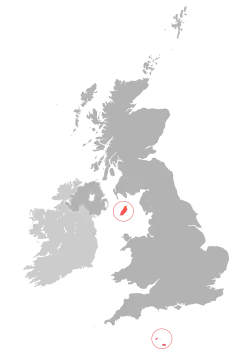United Kingdom–Crown Dependencies Customs Union
The United Kingdom–Crown Dependencies Customs Union (UK-CD Customs Union[4]) or customs arrangements with the Crown Dependencies[5] is a customs union that covers the British Islands. It eliminates all tariff and non-tariff barriers to trade between those islands, and creates a common external tariff with other countries.[4]
United Kingdom–Crown Dependencies Customs Union | |
|---|---|
 The British Islands on a map: United Kingdom
Crown Dependencies | |
| Type | Customs union |
| Members | Crown Dependencies |
| Establishment | 2020 |
| Area | |
• Total | 243,263[lower-alpha 1] km2 (93,924 sq mi) (Unranked) |
| Population | |
• Estimate | 68,393,154 |
| GDP (PPP) | estimate |
• Total | £2,288,612 trillion ($3,185,015 trillion)[lower-alpha 2] |
| Currency |
|
Although each of the dependencies signed an individual agreement with the UK, these agreements include provision for the inclusion of the other dependencies creating a single customs area between the members.[5]
On 1 January 2021, the United Kingdom extended its membership of the World Trade Organization (WTO) to the Channel Islands.[6][7][8]
History
Prior to the UK's exit from the EU, trade between the UK and Crown Dependencies was governed by protocol 3 of the UK's EU accession treaty.[9]
On 26 November 2018, the UK signed customs agreements with each of the Crown Dependencies to allow free trade to continue to flow across between all the parties by creating a single UK–Crown Dependencies Customs Union.[10]
On 29 December 2020, the UK–Crown Dependencies Customs Agreements took effect and officially created a customs union between the UK and Crown Dependencies.[11]
Objectives
The customs agreements:
- remove customs duties between members
- prohibit quantitive restrictions[lower-alpha 4]
- create a common external tariff
- create a shared safety and security zone
- create a joint customs committee
- create a single customs area.
These agreements also state that they may be terminated at any time by mutual agreement.[13]
Common Transit Convention
On 29 December 2020, the United Kingdom became an independent member of Common Transit Convention, this has been extended to the crown dependencies through the UK–Crown Dependencies customs union and is used as the basis for common transit between members.[14]
Customs alignment
Paragraphs 10 to 12 provide that members of the customs union will align with the UK in areas of customs laws, rules and procedures.[15]
Joint UK-CD Customs Committee
The customs agreements created a joint customs committee (UK-CD Customs Committee).[10] This committee will meet at least once a year and will act as a forum for:
- Exchanging views on common interests regarding the agreements
- Reviewing the operation of the agreements
- Seeking appropriate way and methods to avoid problems occurring in regard to areas covered in the agreements
- Mediation should problems occur regarding areas covered in the agreements.[11]
Customs agreements
See also
References
- Amaya, Nigel (22 March 2018). "What Is A Crown Dependency?". World Atlas.
- Demographic Yearbook – Table 3: Population by sex, rate of population increase, surface area and density (PDF) (Report). United Nations Statistics Division. 2012. Retrieved 9 August 2015.
- "Real GDP per capita". Central Intelligence Agency.
- "Brexit: the impact of the end of the Transition Period on Guernsey and Jersey". Carey Olsen. 18 January 2021.
a new Customs Arrangement (the "UK-CD Customs Union") between the UK and the Crown Dependencies, enabling the Islands to enjoy the benefit of free trade agreements entered into by the UK
- Sweet, Pat (27 November 2018). "UK agrees customs arrangements with crown dependencies". Accountancy Daily.
- "Channel Islands to become part of UK's WTO territory". BBC News. 18 October 2019.
- "Guernsey will get WTO membership after Brexit". Bailiwick Express. 19 October 2019.
- Taylor, Ed (19 October 2019). "Agreement puts Island on 'strongest possible footing' for post-Brexit trade". Jersey Evening Post.
- "The Channel Islands and the European Union". Channel Islands Brussels Office.
- Heath, Richard (26 November 2018). "Brexit: Jersey signs customs agreement with UK". Jersey Evening Post.
participation in a new Joint UK CD Customs Committee
- "Isle of Man, Jersey and Guernsey sign deal with UK over post-Brexit trade". BBC News. 26 November 2020.
- "Quantitative restrictions". World Trade Organization.
- "Customs agreement signed between the IoM and UK". Isle of Man.com. 28 November 2018.
- "Common transit procedures that start outside Great Britain". Croner - i.
- "Part 2 – Arrangement between the Government of the United Kingdom of Great Britain and Northern Ireland and the Government of Jersey Concerning the Establishment and Operation of the United Kingdom-Crown Dependencies Customs Union". Croner-i.
- "New customs arrangements for Crown Dependencies". Tax Journal. 28 November 2021.
Footnotes
- This total is a combined area all of the members [1][2]
- This is the combined total of all members (this citation contains links to all members GDP (PPP) [3]
- Local issue: Guernsey pound,Jersey pound & Manx pound
-
Quantitative restrictions
[12]
Article XI of the GATT 1994 is the main provision regulating quantitative restrictions (QRs). The scope of this provision includes all prohibitions or restrictions other than tariffs or other taxes applied or maintained by a WTO Member on the importation or exportation of goods, which can be made effective through quotas, import or export licensing procedures, or other measures. Although Article XI of the GATT provides for the general elimination of quantitative restrictions, they are allowed in certain specific circumstances. Members' QR notifications seek to provide transparency on these measures, including on its WTO justification.